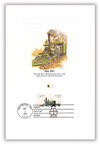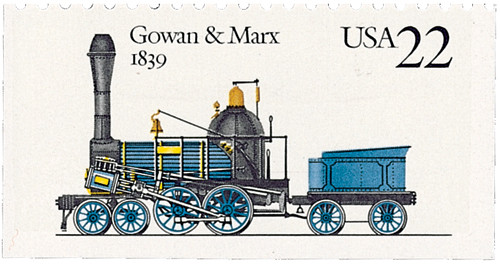
# 2364 - 1987 22c Steam Locomotives: John Bull
U.S. #2364
1987 22¢ John Bull
Steam Locomotives Booklet Pane
- Honors the oldest complete engine preserved in the United States
- Issued at the Baltimore and Ohio Railroad Museum
- Issued for the 7th annual National Stamp Collecting Month
Stamp Category: Commemorative
Set: Steam Locomotives
Value: 22¢, first-class rate
First Day of Issue: October 1, 1987
First Day City: Baltimore, Maryland
Quantity Issued: 78,995,200
Printed by: Bureau of Engraving and Printing
Printing Method: Lithographed and engraved
Format: Four booklet panes of five stamps per booklet
Perforations: 10 horizontal on 1 or 2 sides
Why the stamp was issued: To pay tribute to the contributions of the different engines that sparked the railroad revolution in America
About the stamp design: Richard Leech based his stamp art on original illustrations of the locomotive.
First Day City: The First Day ceremony for this booklet was held at the Baltimore and Ohio Railroad Museum in Baltimore, Maryland.
About the Locomotives Booklet: Richard Leech was originally hired to design Locomotive stamps in 1979. His initial design was a block of four picturing the Stourbridge Lion, the Best Friend of Charleston, the Gowan & Marx, and the Jupiter. The Citizens’ Stamp Advisory Committee decided they wanted a booklet of five stamps and the Jupiter was removed and the John Bull and Brother Jonathan were added.
The 1987 Locomotives stamps were selected as that year’s annual National Stamp Collecting Month issue. Along with those stamps came the theme, “Steaming Along with Stamp Collecting. All Aboard!”
History the stamp represents: On September 15, 1831, the John Bull steam locomotive made its inaugural trip on New Jersey’s first railroad.
The John Bull was built in England by Robert Stephenson and Company for the Camden and Amboy (C&A) Railroad in New Jersey. Once it was completed, it was dismantled and shipped to America. Railroad engineer Isaac Dripps reassembled the locomotive, despite a lack of drawings or instructions on how to do so. As the first locomotive in the state, it was christened number one, and named Stevens, after the president of the C&A Railroad. The Stevens first rode the rails on September 15, 1831.
The railroad wasn’t complete yet, but Robert Stevens hoped to raise money to pay some debts. So he held a test run of the Stevens on short stretch of track that November. He invited members of the New Jersey legislature, local dignitaries, and Napoleon’s nephew Prince Murat. The prince’s wife, Catherine Willis Gray, rushed to get on the train before it left so she could be the first woman to ride a steam locomotive in America.
Once the railroad was completed in 1833, the Stevens was used heavily. Over time, the engine crews took to calling it the Old John Bull, which has long been the personification of England. This was eventually shortened to John Bull, which then became its new name.
The John Bull remained in use until 1866 when it was placed in storage. It was later refurbished and put on public display. These displays included the 1876 Centennial Exposition and the 1883 National Railway Appliance Exhibition. The John Bull was then purchased by the Smithsonian in 1884 as the centerpiece of its first major industrial exhibition. A replica of the John Bull was built so it could still make appearances at exhibitions, but the original train remained on display at the Smithsonian. Then, on September 15, 1981 – its 150th birthday – the John Bull was fired up and operated under its own steam power on a few miles of track, making it the oldest operable steam locomotive. It’s still on display at the Smithsonian, while its replica is at the Railroad Museum of Pennsylvania.
U.S. #2364
1987 22¢ John Bull
Steam Locomotives Booklet Pane
- Honors the oldest complete engine preserved in the United States
- Issued at the Baltimore and Ohio Railroad Museum
- Issued for the 7th annual National Stamp Collecting Month
Stamp Category: Commemorative
Set: Steam Locomotives
Value: 22¢, first-class rate
First Day of Issue: October 1, 1987
First Day City: Baltimore, Maryland
Quantity Issued: 78,995,200
Printed by: Bureau of Engraving and Printing
Printing Method: Lithographed and engraved
Format: Four booklet panes of five stamps per booklet
Perforations: 10 horizontal on 1 or 2 sides
Why the stamp was issued: To pay tribute to the contributions of the different engines that sparked the railroad revolution in America
About the stamp design: Richard Leech based his stamp art on original illustrations of the locomotive.
First Day City: The First Day ceremony for this booklet was held at the Baltimore and Ohio Railroad Museum in Baltimore, Maryland.
About the Locomotives Booklet: Richard Leech was originally hired to design Locomotive stamps in 1979. His initial design was a block of four picturing the Stourbridge Lion, the Best Friend of Charleston, the Gowan & Marx, and the Jupiter. The Citizens’ Stamp Advisory Committee decided they wanted a booklet of five stamps and the Jupiter was removed and the John Bull and Brother Jonathan were added.
The 1987 Locomotives stamps were selected as that year’s annual National Stamp Collecting Month issue. Along with those stamps came the theme, “Steaming Along with Stamp Collecting. All Aboard!”
History the stamp represents: On September 15, 1831, the John Bull steam locomotive made its inaugural trip on New Jersey’s first railroad.
The John Bull was built in England by Robert Stephenson and Company for the Camden and Amboy (C&A) Railroad in New Jersey. Once it was completed, it was dismantled and shipped to America. Railroad engineer Isaac Dripps reassembled the locomotive, despite a lack of drawings or instructions on how to do so. As the first locomotive in the state, it was christened number one, and named Stevens, after the president of the C&A Railroad. The Stevens first rode the rails on September 15, 1831.
The railroad wasn’t complete yet, but Robert Stevens hoped to raise money to pay some debts. So he held a test run of the Stevens on short stretch of track that November. He invited members of the New Jersey legislature, local dignitaries, and Napoleon’s nephew Prince Murat. The prince’s wife, Catherine Willis Gray, rushed to get on the train before it left so she could be the first woman to ride a steam locomotive in America.
Once the railroad was completed in 1833, the Stevens was used heavily. Over time, the engine crews took to calling it the Old John Bull, which has long been the personification of England. This was eventually shortened to John Bull, which then became its new name.
The John Bull remained in use until 1866 when it was placed in storage. It was later refurbished and put on public display. These displays included the 1876 Centennial Exposition and the 1883 National Railway Appliance Exhibition. The John Bull was then purchased by the Smithsonian in 1884 as the centerpiece of its first major industrial exhibition. A replica of the John Bull was built so it could still make appearances at exhibitions, but the original train remained on display at the Smithsonian. Then, on September 15, 1981 – its 150th birthday – the John Bull was fired up and operated under its own steam power on a few miles of track, making it the oldest operable steam locomotive. It’s still on display at the Smithsonian, while its replica is at the Railroad Museum of Pennsylvania.












